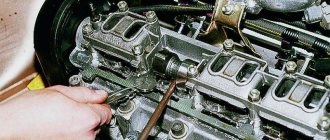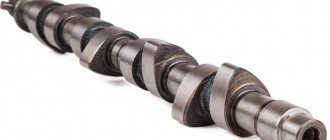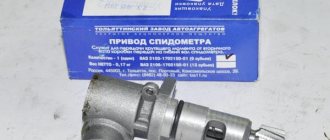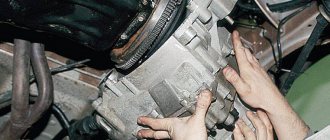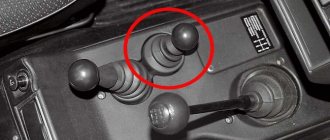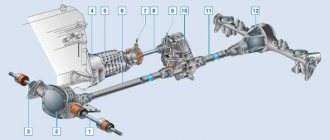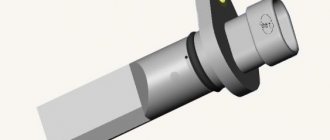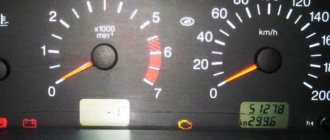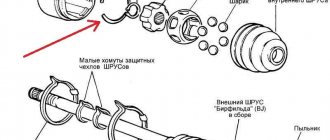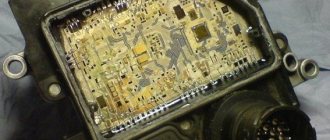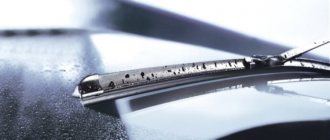RANGE Gearbox 05 (KPP 2108) (I - 2.92; II - 1.81; III - 1.27; IV - 0.96; V - 0.78; VI - 0.69)
Requires 1 washer 2 mm for 4th gear
Belongs to the category of sports rows. 4 gears changed. 1st, 2nd and 3rd gears are lengthened (as in 6th), 4th gear is shortened (as in 8th by 5%), 5th is standard. Usually GP 4.1 is installed. On forced engines - with GP 3.7, 3.9.
RANGE Gearbox 06 (KPP 2108) (I - 2.92; II - 1.81; III - 1.27; IV - 1.06; V - 0.94; VI - 0.78)
Requires 1 washer 2 mm for 4th gear
Sports row. Classic installation - with 6th gear and 4.1 (4.3) gearbox. 1st, 2nd and 3rd gears are lengthened (1st significantly), 4th and 5th are shortened. 5th gear of the 6th row is 4th from the standard row.
RANGE Gearbox 07 (KPP 2108) (I — 2.92; II — 2.05; III — 1.56; IV — 1.31; V — 1.13; VI — 0.94)
Requires 1 washer 2 mm for 4th gear and 1 for 5th gear
Very short - sports (rally, motocross) series. Without 6th gear, it is impossible to achieve a high maximum speed. With 3.7 GP in 5th gear at 5000 rpm. – 128 km/h. When installed with GP 4.1, 4.23 can be used, for example, for short distance competitions such as drag racing.
RANGE Gearbox 08 (KPP 2108) (I — 3.42; II — 2.11; III — 1.35; IV — 0.96; V — 0.78; VI — 0.69)
It is also called “commercial”, since for many years it was the most popular and best-selling product. However, it remains relevant today. 1st gear extended, 2nd and 4th shortened. All changes are minimal (5%), but this is quite enough to correct the shortcomings of the standard series. Most often installed with GPU 4.1. Inexpensive, which is nice. Provides improved acceleration dynamics.
Technical characteristics of the VAZ 2108 gearbox
| R wheels |
| Wheel width |
| Profile |
| Engine speed |
| Main couple |
| 1st gear |
| 2nd gear |
| 3rd gear |
| 4th gear |
| 5th gear |
| 6th gear |
| Results: |
| Type | Mechanics |
| Number of gears | 4 |
| For drive | front |
| Engine capacity | up to 1.3 liters |
| Torque | up to 100 Nm |
| What kind of oil to pour | Gazpromneft GL-4 80W-85 |
| Lubricant volume | 3.0 liters |
| Change of oil | once every 65,000 km |
| Replacing the filter | every 65,000 km |
| Approximate resource | 170,000 km |
Transmission tuning. How to choose gear ratios for a gearbox?
Most of the technologies used in transmission tuning are proven in motorsports.
The transmission of any, especially a sports car, is the most important mechanism for realizing the dynamic characteristics of the engine. Even with a relatively weak engine, the car can be fast due to correctly selected gear ratios. In motorsport, synchronized (as on 'road' cars) and non-synchronized (cam) gearboxes are used. Based on the shifting principle, they are divided into conventional (H-pattern) and sequential (with sequential gear selection, like on motorcycles).
In cars of a fairly serious level of preparation, cam gearboxes are used. They have a number of advantages - they can withstand higher loads (due to the shape of the tooth and the gear-cam clutch engagement), allow experienced pilots to spend less time changing gears due to incomplete squeezing of the clutch or without squeezing the clutch at all, they do not destroy synchronizers (which are simply No).
For normal road traffic, cam gearboxes are practically unsuitable, since they are quite noisy (due to the operation of spur gear pairs), “hard” when engaging a gear, and have a relatively short resource. In addition, they are disproportionately more expensive than synchronized ones and require regular qualified maintenance.
Synchronized gearboxes differ from standard ones only in gear ratios. In some cases (VAZ-2108 and -2110) it is possible to add a 6th gear. The correct selection of gear ratios of the main gearbox pair, the input shaft and the driven gears of the secondary shaft is the key to coordinated operation of the transmission. Gear ratios are selected depending on the power and torque characteristics of the engine, wheel size and, most importantly, on the wishes of the car owner.
The gear ratio is the ratio of the number of teeth on the driven gear to the number of teeth on the drive gear. The higher it is, the “shorter” and “more powerful” the transmission is, that is, the engine very quickly turns out the required number of revolutions, the acceleration occurs just as quickly, but there is a need for frequent gear changes. As a result, there is a slight decrease in the maximum speed in this gear.
Maintenance and repair
Regardless of what kind of drive the car is made with, changing gears, as some drivers say, is a rather complicated operation during a trip. Driving skills are acquired over time. And the more often a person gets behind the wheel, the faster he gains confidence when driving. However, it should be noted that the gearbox experiences the greatest load during the adaptation period. This primarily concerns the mechanical design. A driver who is not confident enough either abruptly releases the clutch pedal or forgets to press it when changing gear.
The first signs that the box is not working properly are:
- Loud noise in the box;
- It takes effort to engage the gear;
- Spontaneous transmission shutdown;
- Oil leakage.
In this case, there is no need to wait for further developments. If you don’t have the skills to repair a vehicle, then you shouldn’t gain this experience by taking the opportunity to dig into the gearbox. Therefore, you should not postpone an extraordinary visit to the service station. When a cable box is installed on the machine, the likelihood of a breakdown is very low.
At the same time, we must remember that there is no such mechanism that cannot be rendered unusable by incorrect actions. Very often, the cause of breakdown is improper operation of the car in general, and the gearbox in particular. Poor quality oil and a faulty clutch play a negative role. The use of spare parts of dubious manufacture also makes a negative contribution. Just like the extreme wear of parts. It is necessary to mention the low quality of technical maintenance of mechanisms on the part of service station personnel. All these features must be taken into account when operating and repairing your machine.
Low gear ratio selection
The lowest gear should ensure that the motorcycle can overcome the greatest incline, taking into account the limitation of traction force on road adhesion, as well as the ability to maneuver at low speed.
This is described by the formulas: – gear ratio of the lowest gear of the transmission to overcome the greatest rise;
– gear ratio of the lowest gear of the transmission to ensure movement at a minimum speed; To ensure both criteria, the gear ratio is selected according to the largest of two values:
Here: – the highest current torque of the engine, from the engine characteristics; – transmission efficiency, when designing it is recommended = 0.92, for motorcycles with a sidecar wheel drive the losses are higher, presumably = 0.85; – rolling radius of the drive wheel; – engine speed at maximum effective torque, also taken from the engine characteristics; – minimum maneuvering speed in low gear, =5 ..6 m/s. Please note that this is not the minimum possible speed, but the speed at which the engine produces the most torque; – the maximum coefficient of road resistance when overcoming the greatest rise. You can approximately determine it from the table:
Table. Maximum coefficient of resistance to movement depending on the type of vehicle
The table is taken from the manual “Traction calculation of a car”, Polytechnic University, 2001. The numerical values of the movement resistance are taken on the assumption that a passenger car overcomes a maximum incline of 20°, and a truck and all-wheel drive – an incline of 30°. The value of ψ for a front-wheel drive car is less than for a rear-wheel drive car does not mean that it is easier for it to climb uphill, but that as a result of the unloading of the drive wheels on the climb, it will develop less traction force.
As for the choice of ψ for a motorcycle, I can assume a range of 0.36 ... 0.6 for different applications of the motorcycle (lower value for primarily road use, higher value for rough terrain).
When going uphill, a single motorcycle behaves close to an all-wheel drive vehicle. At the maximum lift angle, up to 92% of the weight falls on the drive wheel. A motorcycle with a sidecar and only rear-wheel drive is more reminiscent of a rear-wheel drive car with the drive wheel loaded at 60...70% of its total weight.
Of course, you can deviate from the calculated values of the lower gear ratios both up and down.
Gear shift mechanism
The gearshift mechanism is usually mounted in gearbox covers and is used to select, engage, and disengage gears. In addition, devices are installed in the gear shift mechanism that prevent the inclusion of two gears at the same time and prevent spontaneous gear shifting.
The main requirements for this mechanism are ease and simplicity of gearbox control, noiseless and smooth gear shifting, reliable locking of the engaged gear, prevention of simultaneous engagement of two or more gears, as well as protection from engaging a gear opposite to the vehicle's movement while moving. In addition, the activation mechanism must be reliable, durable, not requiring complex adjustments and easy to maintain. Malfunctions of the gear shift mechanism can lead to damage to parts and failure of such an expensive unit as a gearbox.
***
The gearbox shift mechanism of a truck (Fig. 1, a) consists of three rods, three forks, three clamps with balls, a fuse for engaging first gear and reverse gear and a locking device. Rods 8, 9, 11 are located in the holes of the internal bosses of the crankcase cover 1. Forks 5, 7, 10 are attached to them, connected to the synchronizer carriages and to the movable gear wheel for engaging first gear and reverse gear.
Clamps 4 hold the rods in the neutral or engaged position, which prevents spontaneous gear disengagement. Each retainer is a ball with a spring installed above the rods in special sockets in the crankcase cover. The rods for the clamp balls have special grooves (holes). Moving the rod with the fork, and therefore the synchronizer, is only possible when force is applied by the driver, as a result of which the ball sinks into its seat.
The locking device prevents two gears from being engaged simultaneously. It consists of a pin 12 and two pairs of balls 6 located between the rods in a special horizontal channel of the crankcase cover. When any rod moves, the other two are locked with balls that fit into the corresponding grooves on the slides.
In order to prevent accidental engagement of reverse gear or first gear when the vehicle is moving, a fuse is mounted in the wall of the gearbox cover, consisting of a bushing, a ring with a spring 3 and a stop. To engage first gear or reverse gear, it is necessary to press the fuse spring all the way, for which some force is applied to the driver control lever.
***
The gear shift mechanism of a passenger car (Fig. 1, b) is arranged as follows. Rod 14 of the third and fourth gear shift fork is installed in the holes of the front and rear walls of the crankcase, and rods 13 and 16 are installed in the holes of the rear wall and crankcase boss.
The 15, 21, 23 gear shift forks are secured with a bolt on each rod. To hold the rods in the neutral position and in one of the extreme positions when the gear is engaged, they have three sockets, to which the retainer ball 20 is pressed by a spring 19. The clamps are located in bushings and are closed with a cover 18. In the head of each rod there is a groove into which the lower end of the gear shift lever fits.
The locking device consists of three locking blocks 17. The two outer blocks are installed in the holes of the rear wall of the crankcase, and the middle block is in the hole of the rod 14. When the rod 13 or 16 moves, it squeezes out a block that fits into the socket of the middle rod and at the same time presses the other through the middle block cracker to the socket of the opposite rod. This way, these rods will be locked in the neutral position. When moving the middle rod 14, two crackers are squeezed out at once and the outer rods 13 and 16 are fixed.
***
Academic disciplines
- Engineering graphics
- MDK.01.01. "Car design"
- General structure of the car
- car engine
- Car transmission
- Steering
- Brake system
- Suspension
- Wheels
- Body
- Car electrical equipment
- Basic car theory
- Basics of technical diagnostics
- Fundamentals of hydraulics and heat engineering
- Metrology and standardization
- Agreecultural machines. Agreecultural equipment
- Basics of agronomy
- Transportation of dangerous goods
- Materials Science
- Management
- Technical mechanics
- Tips for graduate student
Olympics and tests
- "Engineering graphics"
- "Technical Mechanics"
- "Engine and its systems"
- "Car chassis"
- "Car electrical equipment"
Backstage
On modern cars, including the new Grants, Kalinas, and Priors, gearboxes with cable drive gears are installed, making gear shifting easy and precise. In Samara: 2114 -2113-2115 the gear drive is carried out not by a cable, but by a rocker.
Backstage
The slide is a development from the 80s, so the gears may not engage the first time, may not engage well, etc.
On sports tuned cars they often install a “short-throw” rocker.
The essence of the short-throw shifter is that the path of the gearshift lever from neutral to gear becomes shorter than it was before. Simply put: the gears are easier to engage, the lever travel is shorter, which gives a significant advantage when shifting.
Explanations for the table.The table does not show all multitronic boxes, there are more than 300 of them at the moment, but only the most common ones found on Russian territory.
Control units - if the second letters are indicated in brackets, there has been a change in number. If two numbers are indicated, the second with the designation (7) , then there are two blocks for this box for a 6- and 7-disc clutch.
Hydraulics version - full designation of the valve block - 01J325031**. ** - two letters in the table. There were room changes. BC=S,AE,AM,AF,AT. BP=AQ. CD=BF,BJ. “Good” boxes are only with CD hydraulics.
Date of issue . If months are not indicated, then the model year , usually from the 06th month of the previous year to the 06th month of the current year.
Designation
| Vehicle model | Motor | Gear ratio | Gearbox | Control block | Hydraulic | Release | |
| DZN | A6 4B | 2.8 ACK AMX | 51\46 | 43\9 | 01J927156JD(J) | B.C. | 2000-2001 |
| EVE | A4 8E | 2.0 ALT | 57\41 | 41\9 | 01J927156DS (AE) | B.C. | 12\00-04\01 |
| EZF | A6 4B | 2.4 AML | 54\43 | 43\9 | 01J927156DQ(K) | B.C. | 2000-2001 |
| EZN | A6 4B | 2.8AMX | 51\46 | 43\9 | 01J927156EA(?) | B.C. | 2000-2001 |
| FGC | A6 4B | 1.8AWT | 54\43 | 43\9 | 01J927156EC | B.C. | 2001 |
| FNW | A6 4B | 2.4 AML | 54\43 | 43\9 | 01J927156DR(CB) | B.C. | 2001 |
| FNX | A6 4B | 2.8AMX | 51\46 | 43\9 | 01J927156EB(CA) | B.C. | 2001 |
| FRC | A4 8E | 2.4 AML | 54\43 | 43\9 | 01J927156DB | B.C. | 2002 |
| FRW | A6 4B | 1.8AWT | 54\43 | 43\9 | 01J927156CG | B.C. | 2002-2003 |
| FRX | A6 4B | 2.0 ALT | 57\41 | 43\9 | 01J927156CH | B.C. | 2002-2003 |
| FRY | A6 4B | 2.4 AML | 54\43 | 43\9 | 01J927156CJ | B.C. | 2002-2003 |
| FSA | A6 4B | 3.0 ASN BBJ | 51\46 | 43\9 | 01J927156CL 4B1910155N(7) | B.C. | 2002-2003 |
| FSB | A6 4B US | 3.0 AVK | 53\45 | 43\9 | 01J927156CE | B.C. | 2002 |
| FSC | A6 4B | 2.5AYM | 51\46 | 43\9 | 01J927156CN 4B1910155D(7) | B.C. | 2002 |
| FSD | A4 8E | 1.8AVJ | 54\43 | 43\9 | 01J927156CP | B.C. | 2002 |
| FSE | A4 8E US | 1.8 AMB | 57\41 | 43\9 | 01J927156CQ | B.C. | 2002 |
| FSF | A4 8E | 2.0 ALT | 57\41 | 41\9 | 01j927156CR | B.C. | 2002 |
| FSG | A4 8E | 3.0 ASN BBJ | 51\46 | 43\9 | 01J927156CS | B.C. | 2002 |
| FSH | A4 8E US | 3.0 AVK | 53\45 | 43\9 | 01J927156CF 8E2910155P(7) | B.C. | 2002 |
| FSL | A4 8E | 2.5AYM | 51\46 | 43\9 | 01J927156CT 8E2910155E(7) | B.C. | 2002 |
| F.W.L. | A6 4B | 1.9 AVF | 51\46 | 43\9 | 01J927156DE 4B1910155(7) | B.C. | 2002-2003 |
| FYX | A4 8E | 2.4 AMM BDV | 54\43 | 43\9 | 01J927156DB | B.C. | 2003 |
| GAC | A6 4F | 2.4 BDW | 54\43 | 43\9 | 4F0910155M | B.C. | 2005 |
| G.E.B. | A4 8E | 1.8 BFB | 54\43 | 43\9 | 01J927156ET | B.C. | 2003 |
| G.E.C. | A4 8E | 2.5BCZ | 51\46 | 43\9 | 01J927156FA 8E2910155F(7) | B.C. | 2003 |
| GGP | A6 4B US | 3.0 AVK | 53\45 | 43\9 | 01J927156FD | B.C. | 2003 |
| G.G.S. | A4 8E | 2.0 ALT | 57\41 | 43\9 | 01J927156FH | B.C. | 2003 |
| GGT | A4 8E US | 1.8 AMB | 57\41 | 43\9 | 01J927156FF | B.C. | 2003 |
| G.H.D. | A6 4B | 2.5BCZ | 51\46 | 43\9 | 01J927156FK 4B1910155E(7) | B.C. | 2003 |
| GHF | A6 4B | 3.0 ASN BBJ | 51\46 | 43\9 | 4B0910155 | B.P. | 2004 |
| GHK | A6 4B | 2.4 AML BDV | 54\43 | 43\9 | 4B0910155G | B.P. | 2004 |
| G.H.M. | A6 4B | 2.0 ALT | 57\41 | 43\9 | 4B0919155F | B.P. | 2004 |
| GHQ | A6 4B | 1.9 AVF | 51\46 | 43\9 | 4B0919155C 4B1910155A(7) | B.P. | 2004 |
| GHR | A4 8E | 3.0 BBJ | 51\46 | 43\9 | 8E0910155 | B.P. | 2004 |
| G.H.T. | A4 8E | 2.4 BDV | 54\43 | 43\9 | 8E0910155J | B.P. | 2004 |
| G.H.U. | A4 8E | 2.0 FSI AWA | 57\41 | 43\9 | 8E0910155G | B.P. | 2004 |
| GHV | A4 8E | 2.0 ALT | 57\41 | 43\9 | 8E0910155E | B.P. | 2004 |
| G.H.W. | A4 8E | 1.8 BFB | 54\43 | 43\9 | 8E0910155K | B.P. | 2004 |
| GHX | A4 8E US | 1.8 AMB | 57\41 | 43\9 | 8E0910155F | B.P. | 06\03-01\04 |
| G.J.A. | A4 8E | 1.9 AVF | 51\46 | 43\9 | 8E0910155C 8E2910155B(7) | B.P. | 2004 |
| G.J.S. | A6 4B | 2.5 BDG | 51\46 | 43\9 | 01J927156GN 4B1910155J(7) | B.C. | 02\03-05\03 |
| GJT | A6 4B | 2.5 BDG | 51\46 | 43\9 | 4B0910155D 4B1910155K(7) | B.P. | 2004 |
| GLY | A6 4B | 1.8AWT | 54\43 | 43\9 | 4B0910155K | B.P. | 2004 |
| GVN | A8 4E | 3.0 BBJ | 51\46 | 43\9 | 4E0910156G | B.P. | 07\03 |
| G.W.L. | A6 4B | 2.5BCZ | 51\46 | 43\9 | 4B0910155N 4B1910155G(7) | B.C. | 06\04-08\04 |
| GWN | A4 8E | 3.0 ASN BBJ | 51\46 | 41\8 | 8E0910155M 8E1910155P(7) | CD | 2005 |
| G.W.Q. | A4 8E | 2.4 BDV | 54\43 | 43\9 | 8E0910156K | CD | 2005 |
| G.W.S. | A4 8E | 2.0 ALT | 57\41 | 43\9 | 8E0910155S | CD | 07\04-09\04 |
| G.W.U. | A4 8E US | 1.8 AMB | 57\41 | 43\9 | 8E0910155T | CD | 07\04-12\04 |
| GXU | A8 4E | 3.0 BBJ | 51\46 | 43\9 | 4E0910155M | CD | 2005 |
| G.Y.J. | A4 8E | 2.0 TD BLB | 51\46 | 43\9 | 8E0910157H | C.E. | 2005-2006 |
| GYZ | A6 4F | 2.0 TD BLB | 51\46 | 43\9 | 4F0910155N | CD | 2006 |
| GZE | A4 8E US | 1.8 AMB | 57\41 | 43\9 | 8E0910155F | B.P. | 2004 |
| GZL | A4 8E | 1.8 BEX | 54\43 | 43\9 | 8E0910156P | B.P. | 2004 |
| HAY | A4 8E | 2.0 ALT | 57\41 | 43\9 | 8E0910155S | CD | 06\04-12\04 |
| HBC | A4 8E | 2.0 ALT | 57\41 | 41\8 | 8E0910157G | CD | 06\04-12\04 |
| HBD | A4 8E | 1.8 BFB | 54\43 | 43\9 | 8E0910156L | CD | 2005 |
| H.B.E. | A4 8E | 1.8 BFB | 57\41 | 41\8 | 8E0910157J | B.P. | 2004 |
| HBH | A4 8E | 1.8 BFB | 57\41 | 43\9 | 8E0910157L | CD | 2005 |
| HCQ | A8 4E | 3.0 BBJ | 51\46 | 43\9 | 4E0910156P | B.P. | 2004 |
| HEB | A4 8E | 2.0 ALT | 57\41 | 41\8 | 8E0910159A | CD | 2005-2006 |
| HED | A4 8E | 1.8 BFB | 54\43 | 43\9 | 8E0910159B | CD | 2005-2006 |
| HEF | A4 8E | 1.8 BFB | 57\41 | 43\9 | 8E0910159C | CD | 2005-2006 |
| H.H.A. | A6 4F | 3.0 BBJ | 51\46 | 43\9 | 4F1910155 | CD | 2005 |
| HHD | A4 8E | 2.0 FSI BGB | 51\46 | 43\9 | 8E1910155 | CD | 2005-2006 |
| HHE | A4 8E US | 2.0 FSI BPG | 51\46 | 43\9 | 8E1910155A | CD | 2005-2006 |
| HHY | A6 4F | 3.2 FSI AUK | 49\48 | 43\9 | 4F0910157K | CD | 01\05-05\05 |
| H.J.A. | A8 4E | 3.2 FSI AUK | 49\48 | 43\9 | 4E0910155N | CD | 2006 |
| HKB | A6 4F | 2.8 FSI BDX | 51\46 | 43\9 | 4F0910157M | CD | 2007-2008 |
| HRX | A6 4F | 2.4 BDW | 57\41 | 43\9 | 4F1910155B | CD | 2005 |
| HRY | A6 4F | 3.0 BBJ | 51\46 | 43\9 | 4F1910155C | CD | 03\05-05\05 |
| HSV | A6 4F | 3.2 FSI AUK | 49\48 | 43\9 | 4F2910155K | CD | 2006 |
| HSW | A6 4F | 3.0 BBJ | 51\46 | 43\9 | 4F2910155M | CD | 2006 |
| HSY | A6 4F | 2.4 BDW | 57\41 | 43\9 | 4F2910155Q | CD | 2006 |
| HVA | A8 4E | 3.0 BBJ | 51\46 | 43\9 | 4E1910155B | CD | 2006 |
| JAW | A6 4F | 2.4 BDW | 57\41 | 43\9 | 4F1910155Q | CD | 2006 |
| JFJ | A6 4F | 2.4 BDW | 57\41 | 43\9 | 4F2910155Q | CD | 2006 |
| J.F.L. | A6 4F | 2.0 TD BRE | 51\46 | 43\9 | 4F2910155S | CD | 2006 |
| JQD | A6 4F | 3.2 FSI AUK | 49\48 | 43\9 | 4F2910155A | CD | 2007 |
| JQH | A6 4F | 2.4 BDW | 54\43 | 43\9 | 4F2910155E | CD | 2007 |
| JQJ | A6 4F | 2.4 BDW | 57\41 | 43\9 | 4F2910155F | CD | 2007 |
| JQL | A6 4F | 2.0 TD BRE | 51\46 | 43\9 | 4F2910155H | CD | 2007 |
| JSP | A8 4E | 3.2 FSI BPK | 49\48 | 43\9 | 4E0910155Q | CD | 2007 |
| JZD | A6 4F | 3.0 BBJ | 51\46 | 43\9 | CD | 2007 | |
| JZM | A4 8E | 2.0 FSI BWE | 51\46 | 43\9 | 8E3910155Q | CD | 2007 |
| JZP | A4 8E | 2.0 ALT | 57\46 | 41\8 | 8E3910155S | CD | 2007 |
| JZQ | A4 8E | 1.8 BFB | 54\43 | 43\9 | 8E3910155T | CD | 2007 |
| KSZ | A6 4F | 2.4 BDW | 54\43 | 43\9 | 4F5910155S | CD | 2008 |
conclusions
The “classical” gear selection algorithm involves determining (strictly) the gear ratio in the highest gear and (not strictly) in the lowest gear. Afterwards, intermediate gears are distributed between these values.
You can start selecting intermediate gears with a uniform distribution with the same q index for all gears. After analyzing the dynamic characteristics constructed for this distribution, you can proceed to correction - small changes in the gearboxes towards bringing them closer together in higher gears.
Overdrive (a gear higher than the one at which maximum speed is achieved, usually fifth) in the classic algorithm is assigned after determining the gear ratio in fourth gear. To do this, you can set a typical indicator q for gears 4-5, analyze the dynamic characteristics and, if necessary, make changes.
